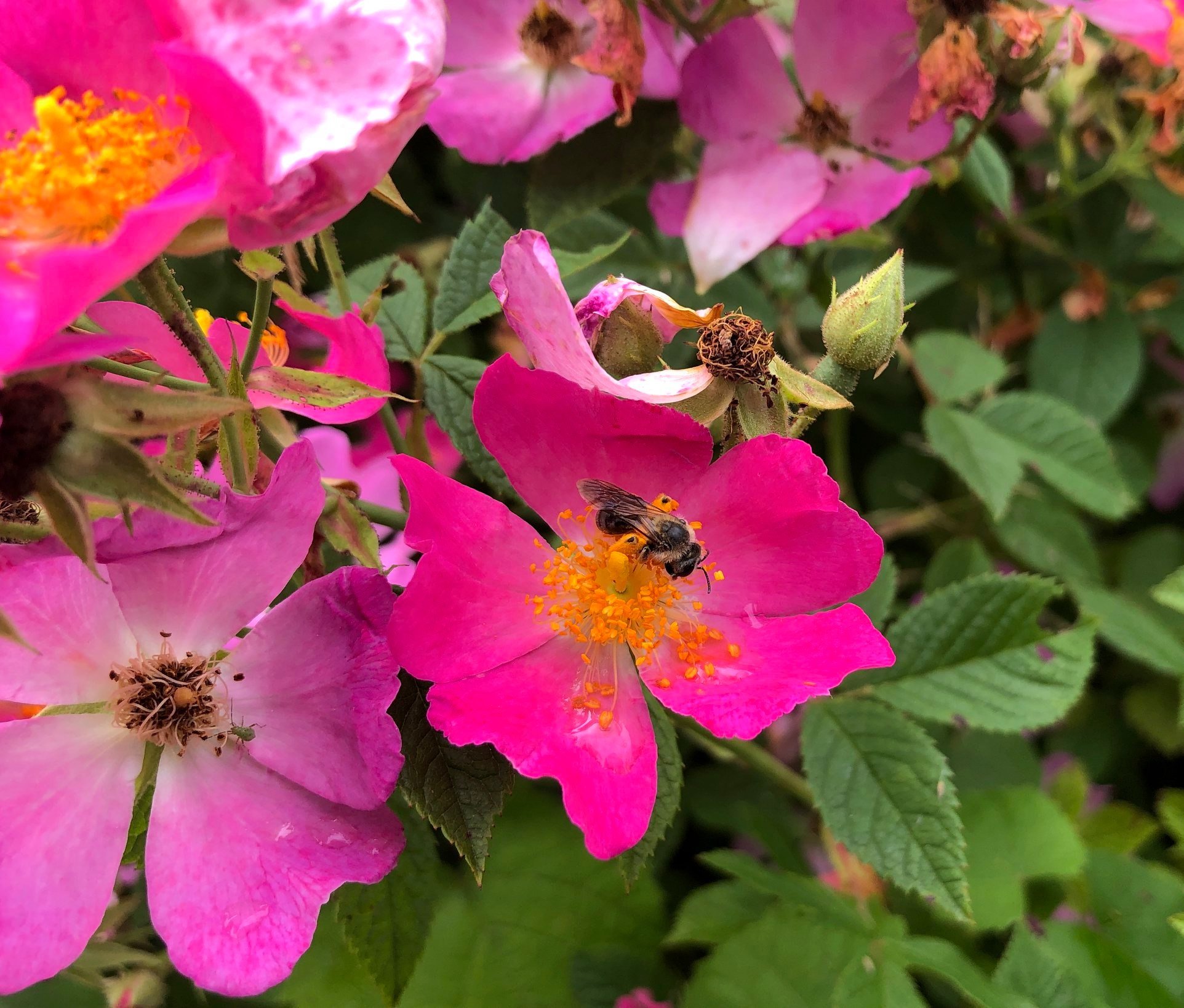A native solitary bee on the native Climbing Rose - Rosa setigera
Native Roses are native to nearly every county of the United States and they extend into Central America and Canada as well. Because ornamental rose pests have been extensively studied, it is known that native roses can support at least 135 different species of native moths/butterflies as host plants. This number makes it one of the best native shrubs for acting as native moth/butterfly host plants. Native Roses aren’t finicky like ornamental roses. Instead they are vigorous and quite competitive.
What stands out amongst native roses though is their ability to support bees. They only produce pollen, not nectar, but this pollen is heavily sought out by solitary bees and bumble bees while in bloom. The fragrant, simple pink flowers range from light pink to a darker hot pink attracting native bees from far and wide. Look for Native Roses while they are in bloom from mid spring into early summer.
CLICK IMAGES BELOW TO EXPAND THEM.
Select/click the images above to expand them then click/tap to advance to the next picture. Also, Turn your cellphone side ways for horizontal pictures, and straight up and down for vertical pictures.
Range Maps created by BONAP
Outside of deep shade of forests, there's a native rose species for every condition.
Rosa carolina (Pasture Rose) is very much adapted to grasslands, able to withstand prairie fire and sprout back up from the ground to bloom again the following year. Very Drought Tolerant.
Rosa setigera (Climbing Rose) can grow in grasslands as well as wetlands as stand alone shrubs or ascending shrubs climbing up into taller thicket species and small trees. Drought Tolerant and Wet Soil tolerant.
Rosa palustris (Swamp Rose) is most adapted to wetlands. It's able to grow in a few inches of water, permanently saturated soil, or just seasonally saturated soils. Very Wet Soil tolerant.
If you match the native rose species to the proper condition listed above, you’ll never have to water them as they are well adapted.
CLICK IMAGES BELOW TO EXPAND THEM.
Select/click the images above to expand them then click/tap to advance to the next picture. Also, Turn your cellphone side ways for horizontal pictures, and straight up and down for vertical pictures.
In addition to being super supportive of native bees and great host plants; they are also excellent nesting habitat for smaller native birds due to the thorns and the fruit they produce is consumed during the winter when other food sources are exhausted. While Native roses offer great nesting protection from native mammals, native snakes have tough enough skin to rub past the thorns and prey on bird nests.
Native Birds and Native Mammals use the fruit in mid to late winter. Compared to the invasive multi-flora rose, native rose hips are at least 3 times as large. Between their insect hosting abilities, pollinator support, nesting attractiveness, and winter consumed fruit, you can’t go wrong by planting native roses in your landscape.
Germination Tips: In the picture above is enough Climbing Rose Hips collected for nursery - scale propagation. For your own landscape use, just collecting 5 - 10 fruits will be sufficient. Separate the seeds from the fruit and place them in a pot with silty soil outdoors for the fall/winter. Strain the silty soil out in the spring, leaving just the seeds behind. Sow 3 to 4 seeds per pot in early spring; they’ll germinate by mid spring.
Receive 40% off of our Native Plant Propagation Guide/Nursery Model book when purchased as a package. deal with either our Native Meadowscaping book or our Native Plant Agriculture book at this link.
Learn about what our Native Meadowscaping book has to offer here at this link.
Learn about what our Native Plant Agriculture Vol. 1 book has to offer here at this link.
Learn about what our Native Plant Propagation Guide & Nursery Model has to offer here at this link.
















